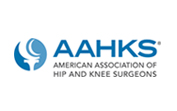Total Knee Arthroplasty
Total Knee Replacement
A total knee replacement is involves replacing all three compartments in the knee joint using a metal cap that resurfacees the end of the thigh bone (femur) and a metal plate that resurfaces the top of the shin (tibia) bone. A thin piece of plastic (polyethylene) sits between the two pieces of metal to recreate the new knee joint. The surgery typically takes about is an hour to an hour and half. Patients often walk the same day as the surgery. The recovery from a knee replacement varies but is usually around 2 months.
The goal of a knee replacement is to restore function and eliminate most of the pain from knee arthritis. Candidates for a knee replacement include people who have knee arthritis, no longer get relief from their knee pain with non-operative treatments, and are significantly bothered by their knee pain. The patient, not the doctor, ultimately decides if their knee pain is significant enough to warrant a knee replacement. Living with the arthritis pain and continuing non-operative treatments are always an option.
Revision Knee Surgery
Replacing a previously implanted prosthesis is more difficult and less predictable than the first surgery. Each case has its own unique problems and risks. In all cases, the risks are much greater than the risks with the first surgery. The outcomes following revision surgery have greatly improved over the years, but the recovery is sometimes longer, and the results are less certain. Often times, special implants with stems and bone graft material is necessary to rebuild the knee joint.
The major indications of a revision knee replacement are knee instability, infection, stiffness, component failure due to wear, and knee pain. If you are having problems with your existing knee replacement, please try to obtain your operative note and a copy of the implants used. This information will significantly help Dr. Duncan determine the cause and solution of the problem.
Pre-operative Joint Replacement Education Class
- Multiple studies have shown that pre-operative education improves patient’s outcomes after joint replacement surgery
- Our hospital offers a free pre-operative instructional class
- Patients are required to attend class prior to surgery.
Medicines
- When possible, please stop aspirin seven days before the surgery
- I also ask that you discontinue "non-steroidal" anti-inflammatory drugs seven days prior to surgery.(such as Advil, Motrin, Alleve, Naprosyn, Celebrex etc.).
- If you take coumadin or other blood thinners (such as Plavix), please contact your medical doctor to find when it is safe to discontinue these drugs. If your medical doctor feels it is unsafe to stop these drugs, you must inform my office asap.
- If you are unsure whether any drugs you take fall in these categories, contact my office or your medical doctor
- All other medications should be continued unless your medical doctor instructs you otherwise. You should ensure that you bring a list of all your medications and their doses to the hospital with you for the pre-operative joint class and anesthesia visit
Day of Surgery
- Patients are asked not to eat anything for 8 hours before their surgery which typically means nothing after midnight.
- We do allow patients to drink water up to 2 hours prior to surgery.
- Most of your normal medicines should be taken the morning of your surgery with a small sip of water. Please ask the anesthesiologist at your pre-operative visit which medicines you should take
- Patients report to the admission office usually around 6 am for a morning case and 8 am for an afternoon case.
- I see all patients in the holding room prior to the operation and answer any questions that may arise.
- Patients may have a spinal or general anesthetic.
- After the surgery, I will update your family members about how the operation went and how you are doing.
- Patients will typically spend about 2 hours in the recovery room before being taken to their hospital room, but there is some variability based on room availability and the patient's recovery from anesthesia.
Wound Closure
- I feel strongly that the wound closure is as important part of the case as the implantation of the components.
- I therefore close the surgical incision with both interrupted and running suture in order to help evenly distribute the force on the skin edges
- All of the sutures dissolve over the following 6 weeks
- The incisions typically do not bleed or drain after surgery
- The water-proof, bactericidal dressing is applied in the operating room and is typically removed a week after the operation. You are given a second dressing to be applied after the first one is removed.
During Your Hospital Stay
- Pain medicine is custom tailored to every patient's need
- Most patients received an oral pain medicine (Percocet or Lortab) every 4 hours as needed and IV dilaudid every one hour as needed for breakthrough pain.
- Patients will receive IV antibiotics for 24 hours after surgery
- Patients will receive a blood thinner for 6 weeks with aspirin.
- Patients are typically encouraged to walk immediately after surgery
- Patients are encouraged to shower the day after surgery
- Physical therapists will work with each patient twice a day helping them learn how to safely walk and work on range of motion.
- All IVs and catheters are typically removed the morning after surgery.
- I see my patients at least once a day. I also try to round on my patients over the weekend, but occasionally, weekend rounds maybe covered by one of my residents.
- The hospital stay is usually about 1 day.
Follow Up
- The patient's first follow up is around 2 weeks after surgery and then at 6 weeks after surgery.
- Patients are seen one year after their surgery for an xray and then every 4 - 5 years after that.
Risks of a total knee replacement
- Blood Clots: Blood clots in your leg veins are possible after any surgery on the lower extremities. The occurrence of blood clots can be minimized with blood thinners, foot pumps, compression stockings, and early mobilization. The main danger of blood clots is if they dislodge and travel to your veins in your lungs. This phenomenon is called a pulmonary embolus and can result in respiratory difficulty, chest pain, or even death. Blood clots typically hurt and cause swelling in your leg. If you have unexplained pain or swelling in your legs, let Dr. Duncan know as he may order a duplex ultrasound to look for a blood clot. If you feel chest pain or breathing difficulties, you should call 911 and then call Dr. Duncan. The risk of these clots causing death has been drastically reduced with blood thinners, and is less than 0.1%. The treatment for a proven blood clot is additional blood thinners, and occasionally a filter in your vein.
- Wound Complications: Occasionally, a knee replacement patient may have some drainage following their surgery. This drainage is often brought on by the blood thinners we have to use. If you have drainage, inform Dr. Duncan’s office immediately. Often I will keep the patient's leg straight with a knee immobilizer, and hold off on the blood thinners for a few days. Sometimes, patients need a repeat operation to wash out the blood from their knee joint.
- Infection: Antibiotics are given before and after surgery to decrease the risk of infection, but an infection still can occur immediately or even years after the surgery. It is usually treated with another surgery to remove infected tissue and occasionally the prosthesis as well. If the components are removed, a revision knee prosthesis can be inserted months later if the infection clears, but sometimes the patient is left without a knee joint or a knee fusion. Although patients rarely have life threatening problems from their joint infection, an infection can be a devastating complication.
- Stiffness: Patients may experience stiffness in the knee joint after surgery. Usually, a stiff knee before surgery is more likely to remain stiff after surgery; however, any knee can lose motion after surgery. It is imperative that patients work hard with the physical therapist after surgery to prevent the knee from getting stiff. Occasionally, the patient must have their knee manipulated under anesthesia to regain the motion lost in the post-operative period
- Component Loosening:Occasional the implanted components may loosen from the bone and change position. Component loosening can occur years after the surgery from wear debris from the plastic liner. The motion of the loose component may cause activity-related pain and require another surgery to revise the components.
- Nerve Injury: Most knee replacements have some numbness on the lateral side of the incision for a few months. This numbness does not typically cause the patients any discomfort or grief. Although extremely rare, nerves to your feet may be injured during surgery. These nerves may or may not recover by themselves.
- Bleeding: Rarely, the blood vessels around the knee may be damaged by the surgery and excessive bleeding may occur after or during the surgery. In these situations, additional surgery may be required to correct the problem. Occasionally, blood gathers in the knee joint (hematoma) and slowly leaks out of the wound and requires a wash out procedure to get the wound to stop bleeding.
- Limp: The pre-operative limp that many people have usually persists for 2-3 months until the muscle strength improves. Occasionally, knee replacement surgery creates a new permanent limp.
- Fracture: The femur, patella, or tibia can crack during surgery when the surgeon is preparing the bone or actually implanting the components. Fractures can also occur years after the surgery from minor trauma. Fractures usually are treated with metal plates and screws and sometimes a revision knee replacement.
- Osteolysis: Polyethylene bearings can wear over many years and cause osteolysis which is the body's response to the plastic wear debris from the knee replacement. The body tends to attack the tiny plastic particles and inadvertently causes the bone around the knee joint to weaken. The weakened bone can lead to fractures or component loosening
- Dislocation: The femoral component rarely can dislocate from the tibia component. Knee replacements with a mobile bearing can also dislocate if the bearing surface rotates more than it should. If your knee replacement dislocates, Dr. Duncan would manipulate your leg under anesthesia or sedation to place the components back together. Occasionally, unstable knee replacements need to be revised to correct this condition if it keeps occurring
- Need for Further Surgery: Though uncommon, total knee replacements occasionally fail sooner than expected. Some other problems can also make further surgery necessary, including: bone forming where it should not, breaking of the bone around the prosthesis (during or after surgery), and irritation of the soft tissues by wire or sutures
- Death: Though very rarely, patients have died following knee replacements. This can be due to underlying medical or heart problems that arise or worsen after the surgery. It can also be due to blood clots traveling to the lungs as mentioned above, or from the stress placed on the body by the surgery.
- Other Problems: This list is meant to cover only the most frequently encountered problems. Just as everyone is unique, so are many problems. Although numerous complications have been reported in the literature, most are minor and rare.
Measures that you can take to help prevent complications include:
- Telling your doctor immediately of any possible infection anywhere on your body. Also let my office know.
- Receiving antibiotics before any dental, urinary, or rectal procedure for two years. You will require pre-procedure antibiotics for a longer period if you have a disease that compromises your immune system. (Call my office if there are any questions)
- Always mention to any doctor performing an invasive procedure on you that you have a hip replacement






